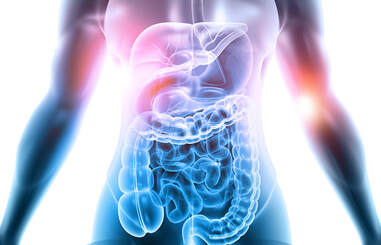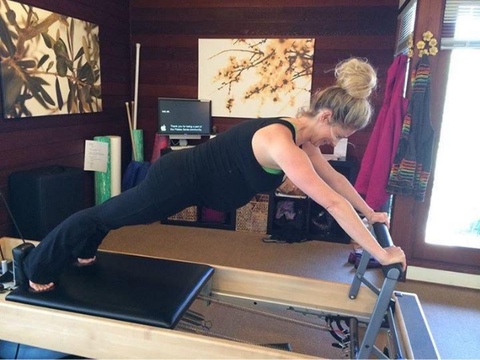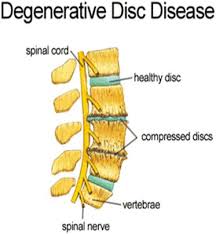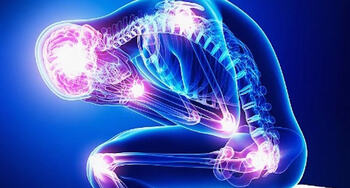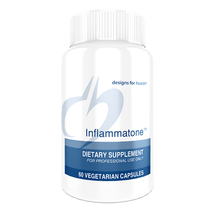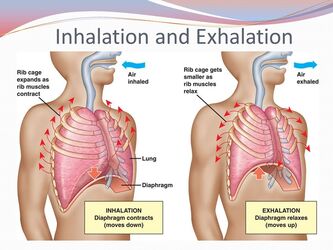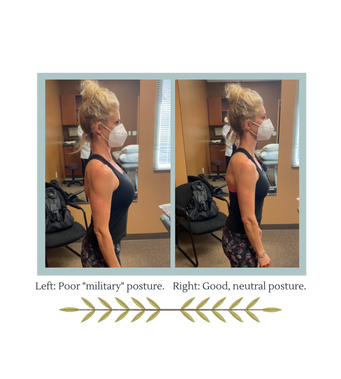 Patients and clients often come to us stating that they have “poor “ posture which they would like to fix. They point out to me that they feel they are slouched and their shoulders are rounded forward. In actuality when we evaluate their standing posture they often have quite the opposite postural fault. We see a very flat neck (cervical spine) and mid back (thoracic spine), with excessive muscular tension resulting… So what causes this type of postural issue? Often we over correct our posture. We feel fatigued in our back muscles and try to prevent "rounding over or slouching", so we compensate by creating an overly erect “military “ type posture, particularly in standing. The problem with this military posing, is excessive straightening of the spine reduces or eliminates its natural curves. These spinal curves, which are lordotic in the cervical and lumbar spine, and kyphotic in the thoracic spine, are what allow the spine to be able to absorb gravitational loads. These curves convert the spine into a flexible spring rather than a rigid rod. Reduction of spinal curves increases the compression upon the intervertebral segments and discs which can eventually contribute or lead to conditions such as degenerative disc disease and arthritis. Faulty posture symptoms include pain, soreness and intolerance to stationary positions, lifting activities, and general daily functional activities. Treatment must be directed to restoring the natural curves of the spine with postural education, and therapeutic exercises. This frequently includes spinal mobility and stability exercises, stretching and strengthening exercises to address muscle tightness, weakness, and proprioceptive deficits. Here are photos of poor "military" posture and better posture with my somewhat flat curves being restored . My current program to improve my posture is: 1. Postural awareness: drop sternum to the horizon, allow upper back to round into neutral kyphosis, draw shoulder blades slightly together. 2. Cat/cow: focus on flexion or rounding of my upper back to increased thoracic kyphosis. 3. Scapular muscles strengthening: band pull backs, rows, and chest flys to strengthen the lower trapezius and serrates anterior. If any of you are interested in a refresher on your standing postural faults, don't hesitate to schedule a fitness evaluation with one of the excellent pilates instructors orphysical therapists at Pilates Sante. With gratitude, Ariel Lehaitre MSPTPIlates Sante Owner/Founder
2 Comments
Pain. At some point in our lives we will experience pain. Whether it be physical, emotional, or both. The fact that the experience of pain can be so drastically different from one individual to the next, has created a lot of inquiry in the medical field. Since I graduated from physical therapy school (over 20 years ago now ) the definition of pain, how it manifests, and how to treat it, has completely evolved and changed. We once thought pain occurred when an apparently noxious stimulus occurred in our physical body creating a direct response to the output experience of pain. What we now know is that the process of pain development is much more complex. It is still agreed that a noxious or uncomfortable stimulus often occurs to start the process, however the signal is then set to the brain which interprets how to respond to this stimulus. Therefore the same type of stimulus response can vary dramatically from one person to the next, based on the brain's process. For example, if I've experienced a history of pain in the bottom of my left foot and I then step on a sharp object, my experience of that pain will likely be quite different from a person without this previous foot “trauma.” It is also proven that other factors will directly impact the degree of pain they report, such as the state of one’s nervous system and the amount of stress a person is experiencing. This newer model of understanding pain is termed the BioPsychosocial Pain Model. It explains that pain is created by the brain directly, and this process is impacted by multiple factors. It confirms that pain is not the direct result of body tissue damage, particularly in chronic pain. Instead, chronic inflammation is often causing or contributing to the chronic pain. Fear, and other negative emotions, can directly increase inflammation contributing to chronic pain. The natural healing “pharmacy” of the body in the calming parasympathetic nervous system state is inhibited when stress, fear, and negative emotions are high. So with this new information, how can we modify how we treat pain as physical therapists or rehabilitation practitioners? We can provide techniques to help our patients or clients transition from the sympathetic nervous system's limbic state of stress and fear to the parasympathetic nervous system's calm and healing state. There are many tools to do this such as mediation & mindfulness; see our Stress Management page, energy work such as Reiki or EFT tapping (emotional freedom technique), in addition to the assistance from other practitioners such as acupuncturists and psychologists. If you’d like to learn more about pain and the Biopsychosocial pain model, here are a few good resources: David Butler and Lorimer Moseley's Explain Pain Adriaan Louw's Why Do I Hurt? Greg Lehman's Recovery Strategies The Back Pain Podcast with Rob Beaven & Dave Elliott
The gut microbiome refers to the “ecosystem” that lines your intestines. This includes more that 100 trillion microbes consisting of bacteria, fungi, and viruses. Gut Microbiota refers to the “good bugs” which are beneficial organisms that exist to create and support our immune system, therefore protecting us from disease. In fact, functional medicine doctor, Dr. Mark Hyman, believes the gut microbiome may be one of the most important regulators of our overall health. Researchers are now finding that imbalances in the gut bacteria can lead to an enormous amount of disease including (but not limited to) cancer, arthritis, autoimmune disease, cardiovascular disease, neurological diseases, depression & other mods disorders, chronic fatigue and pain. Gut microbiota are so powerful that they will modulate what’s termed the “gut-brain axis” which enables them to influence the brain function and therefore pain sensation. So what contributes to poor gut health, and why do so many of us suffer from gut problems or issues?
Healing our gut, can not only prevent us from chronic illness and disease, but will directly decrease the chronic inflammation causing our pain! So how do we heal our gut? I highly recommend working with a functional medicine doctor, naturopathic doctor, or very skilled nutritionist to determine which specific gut imbalances you may be suffering from. However, there are some basic steps you can take independently to begin. Some of Mark Hymans tools to heal your gut include ;
Most often, supplements will also be needed to properly restore the balance of our GI tract. Here are some of my favorites from Designs for Health: Resources : https://drhyman.com/blog/2010/05/20/is-your-digestive-system-making-you-sick/ https://www.drweil.com/diet-nutrition/anti-inflammatory-diet-pyramid/ *The gut-brain axis (GBA) consists of bidirectional communication between the central and the gut or “enteric” nervous system, linking emotional and cognitive centers of the brain with peripheral intestinal functions. 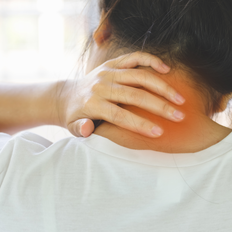 When we are dealing with chronic conditions or pain, we occasionally have flare ups. There may be a mechanical reason for increased pain, such as prolonged sitting for low back pain or sleeping in a poor position for cervical pain. Other times, there may not appear to be a specific reason for increased symptoms, which can be frustrating! Either way, there are steps you can take to feel empowered to control your pain. Below are a few steps to help manage pain and inflammation:
Remember that flare up in symptoms are temporary, and the body can heal and recover! We are here for you, and are deeply grateful for you trusting us with your care! “Your body’s ability to heal is greater than anyone has permitted you to believe.“ In gratitude, Ariel Lehaitre Pilates Santé Owner & Physical Therapist What is Pilates? Pilates is an increasingly popular form of exercise for people of all ages and fitness levels. It is a low impact, versatile, and effective option for people wanting to improve their strength, posture, balance, flexibility and muscle tone. Pilates exercises focus on strengthening the lower abdominal muscles and pelvic floor, providing a ‘stable core’ that supports the back and allows efficient movement. Exercise programs can be extensively modified to focus on different body parts and accommodate individual needs. Exercises can be performed on a mat or with resistance provided through Pilates equipment known as ‘reformers’ and ‘trapeze tables’, and other smaller equipment such as exercise balls and resistance bands. Pilates for Labor Preparation Why is deep breath so important in labor? How can a calm inward focus change your birth? A woman who is in tune with her body and her physical capabilities will have a much more empowered labor. It is not necessary to tell a laboring woman when or how to breathe if she is already breathing deeply and directed her intention with her breath, which is learned through the pilates method. A pilates client in labor will probably not need to know when to push or for how long. She will simply push when her body tells her to because she has learned to listen. Certified professional midwife Stacey Haugland notices very positive effects of pilates during births. How does pregnancy affect the abdominal muscles, back and pelvic floor? During pregnancy, the abdominal (tummy) muscles are stretched to make room for the growing baby. This may weaken the muscles, particularly the deep abdominal muscles. Deep abdominal muscles are responsible for providing support to the back (working like a corset). Lack of support makes the back vulnerable to injury. This is made worse by the hormone relaxin, which is released in pregnant women to soften the ligaments and allow the pelvis to stretch during delivery. All ligaments are softened by relaxin, including the ones in the back. With reduced support from ligaments and abdominal muscles, many pregnant women experience back pain. Relaxin remains in the body for some time after the baby is born. It is therefore important to protect the back not only during pregnancy, but also after birth, particularly when lifting, bending, breastfeeding, etc. The pelvic floor muscles are responsible for controlling the bladder and bowel. They are weakened as they stretch and hold the weight of the growing baby. Weak pelvic floor muscles can result in difficulty controlling the bladder or bowel (incontinence) and can impact on sexual function. For example, some women find they leak urine when they cough or sneeze (stress incontinence). Around 46% of pregnant women in Australia experience urinary incontinence, and 30% have ongoing problems after delivery. Is Pilates useful in pregnancy?Pilates is an ideal exercise during pregnancy as it is designed to strengthen the deep abdominal and pelvic floor muscles. Strength in these areas is known as ‘core stability’. These exercises can be performed in positions that are suitable for women at all stages of pregnancy, such as on hands and knees. Such exercises may take the stress off the back and pelvic floor, and help position the baby for delivery. Pelvic floor exercises have been shown to reduce urine leakage in women with stress incontinence and women who have to rush to get to the toilet on time. Is Pilates safe in pregnancy? It is important to check with your doctor or midwife before starting any new exercise program during pregnancy. If you have not done Pilates before pregnancy, it is essential to receive input from a Pilates instructor or physiotherapist in a setting where you can receive individual attention. Do not attempt exercises on your own until a professional has assessed your performance.
Certain exercises are no longer appropriate from mid pregnancy onwards due to the positions they require (e.g. lying on your tummy or flat on your back). However, exercises on hands and knees, in sitting, and in kneeling positions are all likely to be safe. As your pregnancy progresses the muscles become more stretched, and it may become more difficult to achieve good contractions. References
Many of us with low back pain have been told by our doctors or therapists to strengthen our core. But what does that mean exactly? Is the core purely our abdominal muscles? And how exactly do our abdominal muscles help our back from hurting? The core is not just our abdominal muscles, but rather our entire torso! Our core encompasses our pelvis all the way to our rib cage. Our core is a cylinder of sorts, creating a support system around all sides of our body. The specific muscles that make up our core, include our
Here are a few of our videos demonstrating therapeutic core exercises:
If you have any questions about your home core exercises, please don’t hesitate to ask your instructor for assistance. If your exercises begin to feel easy, please inquire about core exercise progressions as well! Thank you so much for trusting us with your care. Warmly, Ariel Pilates Sante owner/founder Over the last 20 years as a physical therapist treating chronic conditions, I have learned a lot about about pain, inflammation and the healing process. However not until recently, did I understand the incredible response that diet and nutrition can have on inflammation and symptoms. Tammy Parkinson is the incredible Nutritionist and lifestyle coach that I’ve been consistently working with since November 2020, and I feel better in my 40s than I did in my 20s! Whenever I have this kind of experience, I want to share it with YOU! If your healing journey is feeling slow, I highly recommend you consider approaching your back or neck pain as part of a whole body treatment approach...looking specifically at how you can decrease inflammatory foods that are contributing to your pain, and increase anti inflammatory measures. I’ve fallen in love with Dr. Mark Hyman’s Nutritional advice. He makes this vastly growing and complex topic easier to understand and apply. In addition to diet changes, I’ve become a bit if a supplement “junkie”. I truly believe with the current food industry, no matter how “clean” we eat, we are still lacking. Some of the supplements I’ve been taking that have made a great difference on my inflammation, mood and fatigue are:
Whole Body Collagen - in my morning coffee :) Plant Based Protein Powder - in my morning smoothie Essential Greens - this is so good in just water Inflammatone - I take this any time I'm in pain, even more effective when combined with fish oil I wish you all the best in your healing journey. Thank you so much for trusting us with your care. Warmly, Ariel Many of our patients with neck and low back pain come to us with a diagnosis of degenerative disc disease, but are not clear on what this means. Degenerative Disc disease (DDD) is the process of losing disc height The inner most part of the intervertebral disc called the nucleus pulposus, looses fluid and often small cracks or fissures develop in outer annulus of disc. DDD is not necessarily a "normal" process of aging, but a common process. It is often a progression of previous disc herniation or bulge, but can occur at the same time. DDD can occur in individuals as young a 30 years old ,and into 90 years of age. Common Symptoms of DDD include :
DDD is most commonly diagnosed by an MRI. Treatment can include oral anti-inflammatories, cortisone injection into the spine, spine traction, and physical therapy. Nearly 90% of our patients at Pilates Sante have DDD in their neck and pain. Very often these clients improve with lifestyle adjustments and specific therapeutic pilates exercises. A couple of common exercises we might give include :
For any questions or concerns about your spine pain, feel free to contact us at Pilates Sante! What is inflammation? We generally have two different inflammatory responses. Acute inflammation is a necessary (and helpful) short term immune system response to ward off “invaders” such as pathogens, bacteria, viruses, etc. Immune cells will rush to the site of injury or pathology to help heal and recover. This occurs with musculoskeletal injuries. Chronic inflammation is long term, sustained inflammation in various systems of the body caused by repeated “hits” to the immune system such as poor diet, lack of sleep, sedentary lifestyle, and high stress levels. Chronic inflammation is the root of most diseases and health conditions such as heart disease, arthritis, chronic pain, IBS, high blood pressure and even depression. Chronic Inflammation is typically the cause of pain. “All acute and chronic disease states have pathophysiology that is multifactorial, but nearly all have an inflammatory component to them” Generally our new patients or clients come to Pilates Sante with symptoms and pain due to excessive inflammation. The inflammation of their condition prevents us from being able to effectively apply pilates therapeutic exercise to improve their condition. Therefore an immediate anti inflammatory regime is needed. This generally includes postural changes, ice, & oral medications such as NSAIDs. Many clients are allergic to NSAIDs or have been on them long term, and are not tolerating them. It seems we have found the solution with Inflammatone. This is a holistic anti-inflammatory supplement which consists of a protein enzyme blend which assists the breakdown of the inflammatory process. Many of our clients have experienced significant decrease in symptoms and increased tolerance for exercise, as well as daily activities.
We also recommend changes in lifestyle such as diet & stress management. Please let us know of you have any questions about your level of inflammation , & whether you could benefit from an anti inflammatory regime. Source: Jackie Miller Designs for Health Breathing is the first thing we do once we are born, and the last thing we do before we die, but how much attention do we often give to our breath? Most of us don’t think about our breathing, likely because it is automatic and occurs nearly 20,000 times per day. Breathing of course is vital to our existence, and provides for all of our body’s systems. Physiologically, breathing provides oxygen to our all of our vital organs, as well as elimination of toxic substances from our bodies. For our emotional system, it provides control and clarity. In exercise, it provides for efficiency and organization of our musculoskeletal system. Breath is one of the fundamental principles of pilates. Breath with pilates therapeutic exercise creates flow and ease of movement, encourages proper engagement of our deep core musculature, allows for axial elongation or decompression of our spinal segments, and general efficiency and strength of our musculoskeletal system. At Pilates Santé we focus on two types of breathing patterns: diaphragmatic breathing and lateral breathing. Diaphragmatic breathing involves inhaling through your nose, while expanding and relaxing your abdomen, then exhaling through the mouth while engaging your lower abdominal muscles. We often teach this breath technique initially to clients to create a connection to the lower abdominal muscle (transverse abdominus) to facilitate core control. This breath pattern also allows for relaxation and focus for our clients learning the pilates fundamental exercises. Lateral breathing focuses on the expansion of the rib cage and breathing into the sides and back of the ribs. In lateral breathing, we maintain a consistent inward contraction of the deep abdominal muscles, through the inhalation and exhalation. This encourages us to keep our “corset” engaged by recruiting our intercostal muscles (the muscles between each of the ribs). Lateral costal breathing is the primary breath pattern implemented by our rehabilitative pilates clients, so that maximum core support and engagement is maintained through exercise. The timing and direction of inhalations and exhalations we cue are based on the type of movement being performed. Inhalation is often cued to facilitate extension of the spine, while exhalation is for flexion. Inhalation is cued for axial elongation or relaxation, while exhalation is cued for engagement or facilitation. However, as Brent Anderson Polestar Pilates says, “Breath is a tool, not a rule, “ therefore cues should be based on the movement quality of the exercise you are observing in your client. For more on these breath techniques, please refer to our website videos. |
Ariel Lehaitre, AuthorCategories |
Proudly powered by Weebly
